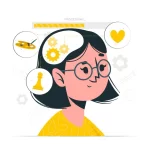Anna Freud
Anna Freud (1895–1982) was an Austrian-British psychoanalyst and the youngest daughter of Sigmund Freud, the founder of psychoanalysis. She made significant contributions to the field of child psychoanalysis and developmental psychology.
Anna Freud’s work focused primarily on the study and treatment of children’s psychological disorders, as well as the influence of early childhood experiences on personality development. She emphasized the importance of the ego in managing conflicts between the individual’s desires and societal demands, as well as the significance of defense mechanisms in coping with anxiety.
One of Anna Freud’s most notable contributions was her establishment of the Hampstead Child Therapy Course and Clinic in London in 1947. This clinic became a leading center for child psychoanalysis and played a crucial role in advancing the understanding and treatment of childhood emotional and behavioral problems.
Throughout her career, Anna Freud wrote extensively on topics such as ego psychology, defense mechanisms, child development, and psychoanalytic therapy techniques for children. Her work continues to influence clinical practice and research in the fields of psychology and psychiatry.
Biography of Anna Freud
Birth of Anna Freud
Anna Freud was born on December 3, 1895, in Vienna, Austria. She was the youngest daughter of Sigmund Freud, the renowned neurologist and founder of psychoanalysis, and Martha Bernays Freud. Anna Freud grew up in a household that was intellectually stimulating and surrounded by prominent figures in the fields of psychology and psychiatry. This upbringing greatly influenced her interest in psychology and her subsequent career as a psychoanalyst specializing in child psychology.
Early life of Anna Freud
Anna Freud grew up in Vienna, Austria, as the youngest daughter of Sigmund Freud and Martha Bernays Freud. Her family environment was intellectually stimulating, with her father being a prominent figure in the emerging field of psychoanalysis.
Anna Freud’s childhood was marked by close relationships with her siblings, particularly her sister Sophie. However, tragedy struck the family when Sophie died suddenly of influenza in 1920. This loss deeply affected Anna and influenced her decision to pursue a career in psychoanalysis, specifically focusing on child psychology.
Despite being the youngest in the family, Anna Freud enjoyed a close relationship with her father and was deeply influenced by his work. She began studying psychology at the University of Vienna, but her education was interrupted by World War I. During the war, Anna volunteered at a hospital, gaining valuable experience in psychiatric nursing.
After the war, Anna resumed her studies and became involved in her father’s psychoanalytic circle. She underwent psychoanalysis herself and began training as a psychoanalyst. Her interest in child psychology grew, leading her to develop her own theories and techniques for understanding and treating children’s psychological disorders.
Anna Freud’s early life experiences, including her upbringing in a household focused on intellectual inquiry and her personal experiences with loss and trauma, played a significant role in shaping her career and contributions to the field of psychoanalysis.
Education of Anna Freud
Anna Freud pursued her education in psychology, although her formal academic path was somewhat unconventional due to the societal norms and educational opportunities available for women during her time. Here’s an overview of her educational journey:
- Informal Education: Anna Freud received an informal education within her family environment, which was intellectually stimulating due to her father’s prominent role in the emerging field of psychoanalysis. She was exposed to discussions and debates about psychology and human behavior from a young age.
- University Studies: Anna began studying medicine at the University of Vienna, but she later switched her focus to psychology. At that time, women faced significant barriers to higher education, and it was uncommon for them to pursue advanced degrees in academia.
- Psychoanalytic Training: Anna underwent psychoanalytic training with her father, Sigmund Freud, and other prominent psychoanalysts of the time. This training involved both theoretical study and practical experience in conducting psychoanalytic therapy sessions.
- Clinical Experience: Anna gained clinical experience through her work at the Vienna Psychoanalytic Society and later through her own clinical practice. She also worked with children during World War I, volunteering as a nurse at a hospital and gaining valuable insights into child psychology.
- Self-Study and Research: Throughout her life, Anna engaged in self-directed study and research to further her understanding of psychoanalysis and child psychology. She published numerous papers and books on topics such as ego psychology, defense mechanisms, and child development.
Anna Freud’s education was shaped by a combination of formal academic study, practical experience, and self-directed learning within the context of the psychoanalytic community in Vienna. Despite the societal barriers she faced as a woman, she made significant contributions to the field of psychoanalysis and child psychology through her dedication to learning and research.
Relationship of Anna Freud with her parents
Anna Freud’s relationship with her parents, Sigmund Freud and Martha Bernays Freud, was complex and multifaceted, characterized by both closeness and tension, as well as mutual admiration and professional collaboration. Here’s a closer look at their relationship dynamics:
- Close Bond: Anna had a close and affectionate relationship with both of her parents. Despite Sigmund Freud‘s busy professional life, he was attentive and supportive of Anna’s intellectual and academic pursuits. Martha Bernays Freud, Anna’s mother, also played an important role in her upbringing, providing emotional support and guidance.
- Intellectual Influence: Growing up in a household where psychoanalytic ideas were constantly discussed, Anna was deeply influenced by her father’s work. She admired Sigmund Freud’s intellect and revolutionary ideas in the field of psychology, which inspired her own interest in psychoanalysis and child psychology.
- Professional Collaboration: Anna Freud’s professional career was closely intertwined with her father’s work. She underwent psychoanalytic training with him and other prominent psychoanalysts, and she later became a respected psychoanalyst in her own right. Throughout her career, Anna collaborated with her father on various research projects and clinical cases, contributing to the development of psychoanalytic theory and practice.
- Personal Conflicts: Despite their close relationship, Anna and Sigmund Freud occasionally experienced personal conflicts and disagreements, particularly regarding Anna’s desire for independence and her differing theoretical perspectives on certain aspects of psychoanalysis. However, these conflicts did not significantly undermine their mutual respect and affection for each other.
- Emotional Support: Throughout her life, Anna found emotional support and understanding from both of her parents, especially during challenging times such as the death of her sister Sophie and her own struggles with illness. Sigmund and Martha Freud provided a supportive environment that nurtured Anna’s intellectual and professional development.
Overall, Anna Freud’s relationship with her parents was characterized by a blend of admiration, collaboration, and occasional conflict. Their close bond and shared interest in psychoanalysis played a significant role in shaping Anna’s career and contributions to the field of psychology.
Marital life of Anna Freud
Anna Freud never married. Instead, she dedicated her life to her work as a psychoanalyst, focusing particularly on child psychology and the treatment of children with emotional and behavioral issues. Throughout her career, Anna Freud remained single and did not have any children of her own.
Despite not marrying, Anna formed close and meaningful relationships with colleagues, friends, and family members, including her parents and siblings. She also developed significant professional partnerships and collaborations within the psychoanalytic community, contributing to her rich and fulfilling personal life.
Anna Freud’s decision not to marry allowed her to fully devote herself to her work and to become one of the most influential figures in the field of psychoanalysis, especially in the area of child psychology. Her contributions to the understanding and treatment of children’s psychological disorders continue to be highly regarded in the field of psychology.
Social life of Anna Freud
Anna Freud’s social life was characterized by a combination of professional engagements, intellectual pursuits, and personal relationships. Here are some aspects of her social life:
- Professional Engagements: As a prominent psychoanalyst, Anna Freud was actively involved in various professional circles and organizations. She participated in conferences, seminars, and workshops, where she presented her research findings and exchanged ideas with colleagues in the field of psychoanalysis.
- Intellectual Pursuits: Anna had a deep passion for learning and intellectual inquiry, which she pursued both professionally and personally. She engaged in scholarly activities such as writing papers and books, conducting research studies, and staying updated on the latest developments in psychoanalytic theory and practice.
- Colleagues and Collaborators: Anna formed close relationships with fellow psychoanalysts and researchers, collaborating on research projects, sharing clinical experiences, and exchanging ideas about psychoanalytic theory and practice. These professional relationships were an important source of support and inspiration for Anna throughout her career.
- Personal Relationships: Although Anna never married, she maintained close relationships with family members, friends, and colleagues. She had a close bond with her siblings, particularly her sister Sophie, before her untimely death. Anna also formed meaningful friendships with individuals outside of the psychoanalytic community, enjoying social gatherings and leisure activities with friends.
- Legacy and Influence: Anna Freud’s social life extended beyond her lifetime through her enduring influence on the field of psychoanalysis and child psychology. Her writings, teachings, and clinical work continue to inspire generations of psychoanalysts and mental health professionals, shaping the way we understand and approach the treatment of children’s psychological disorders.
Overall, Anna Freud’s social life was enriched by her professional accomplishments, intellectual pursuits, and personal relationships, all of which contributed to her lasting impact on the field of psychology.
Followers of Anna Freud
Anna Freud, being a prominent figure in the field of psychoanalysis and child psychology, had many followers and admirers who were influenced by her work and ideas. Some of her followers include:
- Psychoanalysts and Therapists: Many psychoanalysts and therapists were inspired by Anna Freud’s contributions to the field of psychoanalysis, particularly her work in child psychology and the treatment of children’s emotional and behavioral issues. Her theories and techniques have had a profound impact on the practice of psychoanalytic therapy, influencing generations of mental health professionals.
- Researchers and Academics: Researchers and academics in the fields of psychology, psychiatry, and child development have been influenced by Anna Freud’s writings and research findings. Her studies on ego psychology, defense mechanisms, and child development have contributed to our understanding of human behavior and psychological development.
- Students and Trainees: Students and trainees in the field of psychoanalysis often study Anna Freud’s work as part of their training curriculum. Her books, articles, and case studies are frequently assigned readings in psychoanalytic training programs, helping to shape the next generation of psychoanalysts and therapists.
- Educators and Clinicians: Educators and clinicians who work with children and adolescents may incorporate Anna Freud’s theories and techniques into their practice. Her insights into the psychological needs of children and effective therapeutic approaches have informed clinical interventions in schools, clinics, and therapeutic settings.
- Advocates for Children’s Mental Health: Anna Freud’s advocacy for children’s mental health and well-being has inspired individuals and organizations around the world to prioritize the needs of children and adolescents in mental health policy and practice. Her legacy continues to influence efforts to promote early intervention, prevention, and treatment of children’s psychological disorders.
Overall, Anna Freud’s followers include a diverse range of individuals who have been influenced by her pioneering work in psychoanalysis and child psychology. Her legacy lives on through the ongoing application of her ideas and the continued pursuit of knowledge in these fields.
Clinical practice of Anna Freud
Anna Freud’s clinical practice was primarily focused on child psychoanalysis, and she made significant contributions to the understanding and treatment of children’s psychological disorders. Here are some key aspects of her clinical practice:
- Psychoanalytic Therapy for Children: Anna Freud developed innovative techniques for conducting psychoanalytic therapy with children, adapting traditional psychoanalytic methods to suit the developmental needs and capacities of young patients. She emphasized the importance of establishing a trusting therapeutic relationship with the child and creating a safe space for exploration and expression.
- Play Therapy: Recognizing the importance of play in children’s emotional expression and development, Anna Freud integrated play therapy techniques into her clinical practice. She used play as a means for children to communicate their thoughts, feelings, and conflicts, allowing for deeper exploration and understanding of their inner world.
- Observation and Assessment: Anna Freud placed great emphasis on careful observation and assessment of children’s behavior, emotions, and relationships as part of the therapeutic process. She used a variety of assessment tools and techniques to gather information about the child’s psychological functioning and to formulate treatment plans tailored to their individual needs.
- Understanding Defense Mechanisms: Drawing on her father’s theory of defense mechanisms, Anna Freud explored how children use defense mechanisms to cope with anxiety and psychological distress. She focused on helping children and their families understand and manage these defenses in order to facilitate emotional growth and development.
- Family Dynamics: Anna Freud recognized the importance of family dynamics in shaping children’s psychological development and behavior. She often worked with parents and caregivers as part of the therapeutic process, helping them understand their child’s needs and providing guidance on effective parenting strategies.
- Hampstead Child Therapy Course and Clinic: In 1947, Anna Freud established the Hampstead Child Therapy Course and Clinic in London, which became a leading center for child psychoanalysis and training. The clinic provided low-cost psychoanalytic therapy for children and families, as well as training opportunities for mental health professionals.
Overall, Anna Freud’s clinical practice was characterized by a deep understanding of child development, a compassionate approach to therapy, and a commitment to advancing the field of child psychoanalysis through innovative techniques and research. Her work continues to influence clinical practice and research in child psychology and psychoanalysis.
Death of Anna Freud
Anna Freud passed away on October 9, 1982, in London, United Kingdom. She was 86 years old at the time of her death. Anna Freud had a long and distinguished career as a psychoanalyst, specializing in child psychology and the treatment of children’s emotional and behavioral issues.
Throughout her life, Anna Freud made significant contributions to the field of psychoanalysis through her clinical work, research, and writing. She established herself as a leading authority on child development and psychoanalytic therapy for children, influencing generations of mental health professionals.
Anna Freud’s death marked the end of an era in the field of psychoanalysis, but her legacy continues to endure through her writings, teachings, and the lasting impact of her contributions to the understanding and treatment of children’s psychological disorders. She remains one of the most influential figures in the history of psychoanalysis, admired for her intellect, compassion, and dedication to improving the lives of children and families.
What were the significant events and experience in Anna Freud’s life that influenced her work?
Several significant events and experiences in Anna Freud’s life influenced her work as a psychoanalyst specializing in child psychology. Here are some key factors that shaped her career and contributions to the field:
- Family Background: Growing up as the youngest daughter of Sigmund Freud, Anna was immersed in an environment where psychoanalytic ideas were constantly discussed and debated. Her father’s pioneering work in psychoanalysis had a profound influence on her intellectual development and sparked her interest in psychology from an early age.
- Education and Training: Despite societal barriers for women at the time, Anna pursued her education in psychology and underwent psychoanalytic training with her father and other prominent psychoanalysts. Her formal education provided her with the theoretical foundation and clinical skills necessary to become a psychoanalyst.
- World War I: During World War I, Anna volunteered as a nurse at a hospital, where she gained valuable experience working with children who had been affected by the trauma of war. This experience deepened her understanding of children’s emotional and psychological needs and influenced her decision to specialize in child psychoanalysis.
- Personal Loss: The death of Anna’s sister Sophie in 1920 had a profound impact on her. This loss prompted Anna to delve deeper into her work as a psychoanalyst and to focus on understanding and treating childhood trauma and grief.
- Professional Collaborations: Throughout her career, Anna collaborated with other psychoanalysts and researchers, exchanging ideas and insights that enriched her own work. Her professional relationships with colleagues such as Melanie Klein and Ernst Kris, despite occasional disagreements, contributed to the development of psychoanalytic theory and practice.
- Establishment of the Hampstead Clinic: In 1947, Anna founded the Hampstead Child Therapy Course and Clinic in London, which became a leading center for child psychoanalysis. Through her work at the clinic, Anna had the opportunity to apply her theoretical insights to clinical practice and to train future generations of child psychoanalysts.
- Observations and Research: Anna’s clinical work with children, combined with her keen observational skills and empirical research, led to groundbreaking insights into child development, defense mechanisms, and the effects of early experiences on personality development. Her observations of children in therapy and her extensive case studies informed her theoretical formulations and therapeutic techniques.
Overall, Anna Freud’s work was shaped by a combination of personal experiences, intellectual influences, and professional collaborations. Her pioneering contributions to the field of child psychoanalysis continue to have a lasting impact on our understanding of children’s emotional and psychological development.
Ideas of Anna Freud
Anna Freud contributed several influential ideas to the field of psychoanalysis, particularly in the realm of child psychology and the treatment of children’s emotional and behavioral issues. Here are some key ideas associated with her work:
- Ego Psychology: Anna Freud expanded upon her father’s psychoanalytic theory by emphasizing the importance of the ego in managing conflicts between the individual’s desires and societal demands. She explored how the ego develops throughout childhood and adolescence, as well as its role in mediating between the id (primitive drives) and the superego (internalized moral standards).
- Defense Mechanisms: Building on Sigmund Freud’s concept of defense mechanisms, Anna Freud conducted extensive research on how children use various defense mechanisms to cope with anxiety and psychological distress. She identified specific defense mechanisms commonly observed in children, such as repression, denial, regression, and reaction formation.
- Developmental Stages: Anna Freud proposed a series of developmental stages that children pass through during their psychological development. She focused particularly on the challenges and conflicts that arise during each stage, as well as the ways in which children resolve these conflicts. Her developmental model provided a framework for understanding the psychological needs and behaviors of children at different ages.
- Play Therapy: Anna Freud pioneered the use of play therapy as a therapeutic technique for working with children. She recognized the importance of play in children’s emotional expression and development, using play as a medium for children to communicate their thoughts, feelings, and conflicts in a nonverbal manner. Play therapy allowed children to explore and work through their issues in a safe and supportive environment.
- Therapeutic Techniques: Drawing on her extensive clinical experience, Anna Freud developed a range of therapeutic techniques specifically tailored to the needs of children. These techniques included interpretation of play, establishing a therapeutic alliance through empathy and understanding, and providing emotional support and containment.
- Understanding Children’s Resistance: Anna Freud explored the concept of resistance in children’s therapy, examining how children may resist the therapeutic process as a means of protecting themselves from anxiety and emotional pain. She emphasized the importance of understanding and addressing children’s resistance in therapy in order to facilitate progress and growth.
Overall, Anna Freud’s ideas have had a significant impact on the practice of psychoanalysis, particularly in the realm of child psychology and the treatment of children’s emotional and behavioral disorders. Her pioneering work continues to inform clinical practice and research in the field of psychology.
Legacy of Anna Freud
Anna Freud’s legacy is substantial, particularly in the fields of psychoanalysis and child psychology. Here are some key aspects of her enduring influence:
- Advancement of Child Psychoanalysis: Anna Freud played a pivotal role in advancing the field of child psychoanalysis. Her innovative approaches to therapy, including play therapy and the observation of children’s behavior, helped establish psychoanalysis as a valuable tool for understanding and treating children’s emotional and behavioral issues.
- Theoretical Contributions: Anna Freud made significant theoretical contributions to psychoanalysis, particularly in the areas of ego psychology, defense mechanisms, and child development. Her insights into the role of the ego in managing internal conflicts and her exploration of children’s developmental stages have had a lasting impact on the field.
- Clinical Practice: Through her clinical work and the establishment of the Hampstead Child Therapy Course and Clinic, Anna Freud trained numerous psychoanalysts and therapists in the specialized treatment of children. Her clinical expertise and therapeutic techniques continue to inform clinical practice in child psychology and psychoanalysis.
- Research and Writing: Anna Freud’s extensive research and writing have contributed to our understanding of children’s emotional and psychological development. Her books, articles, and case studies remain influential resources for students, researchers, and clinicians in the field of psychology.
- Advocacy for Children’s Rights: Throughout her life, Anna Freud was a passionate advocate for children’s rights and well-being. She recognized the importance of creating supportive environments for children to thrive and advocated for policies and practices that promote children’s mental health and development.
- Professional Leadership: Anna Freud’s leadership in the psychoanalytic community helped shape the direction of the field and fostered collaboration among psychoanalysts and researchers. Her contributions to professional organizations and institutions have had a lasting impact on the training and education of future generations of psychoanalysts.
Overall, Anna Freud’s legacy continues to be felt in the field of psychoanalysis and child psychology, where her ideas, methods, and commitment to helping children lead emotionally healthy lives continue to inspire and influence practitioners and researchers around the world.
How Anna Freud's work impact on modern society?
Anna Freud’s work has had a significant impact on modern society in several ways:
- Advances in Child Psychology and Mental Health: Anna Freud’s pioneering work in child psychoanalysis and the treatment of children’s emotional and behavioral issues has contributed to significant advances in child psychology and mental health. Her insights into children’s developmental stages, defense mechanisms, and therapeutic techniques have helped inform modern approaches to understanding and treating children’s psychological disorders.
- Therapeutic Practices: Many of Anna Freud’s therapeutic techniques, such as play therapy and the interpretation of children’s behavior, continue to be widely used in clinical practice today. Mental health professionals working with children often draw upon her methods and principles to provide effective and compassionate care to their young clients.
- Training and Education: Anna Freud’s establishment of the Hampstead Child Therapy Course and Clinic provided a model for specialized training in child psychoanalysis and therapy. Today, similar training programs and educational initiatives continue to prepare mental health professionals to work with children and families, ensuring that they have the necessary knowledge and skills to address children’s psychological needs.
- Advocacy for Children’s Rights: Anna Freud’s advocacy for children’s rights and well-being has helped raise awareness about the importance of creating supportive environments for children to thrive. Her efforts to promote policies and practices that prioritize children’s mental health and development have had a lasting impact on modern society’s understanding of children’s needs and rights.
- Research and Scholarship: Anna Freud’s research and writing have contributed to a rich body of literature on child psychology and psychoanalysis. Her books, articles, and case studies continue to be valuable resources for researchers, clinicians, educators, and students interested in understanding children’s emotional and psychological development.
Overall, Anna Freud’s work has left a lasting legacy that continues to shape modern society’s understanding and approach to children’s mental health and well-being. Her insights, methods, and advocacy efforts have helped improve the lives of countless children and families around the world.
How Anna Freud's work impact on modern psychology?
Anna Freud’s work has had a profound impact on modern psychology in several key areas:
- Child Psychoanalysis and Developmental Psychology: Anna Freud’s pioneering work in child psychoanalysis and developmental psychology has significantly influenced modern theories and practices in these fields. Her emphasis on the importance of childhood experiences, defense mechanisms, and the role of the ego in managing internal conflicts continues to shape contemporary understandings of child development and psychopathology.
- Therapeutic Techniques: Many of Anna Freud’s therapeutic techniques, such as play therapy and the interpretation of children’s play, have become integral components of modern psychotherapy approaches for children. Mental health professionals often draw upon her methods and principles when working with children and adolescents, adapting them to suit the unique needs of each client.
- Ego Psychology: Anna Freud’s elaboration of ego psychology, which focuses on the role of the ego in mediating between the id and the superego, has had a lasting impact on modern psychodynamic theory and practice. Her conceptualizations of defense mechanisms and the ways in which the ego manages anxiety continue to inform contemporary psychoanalytic approaches to understanding personality development and psychopathology.
- Training and Education: Anna Freud’s establishment of the Hampstead Child Therapy Course and Clinic set a precedent for specialized training programs in child psychoanalysis and therapy. Today, similar programs exist around the world, providing mental health professionals with the knowledge and skills needed to effectively work with children and families.
- Research and Scholarship: Anna Freud’s research and writings have contributed to a rich body of literature in the field of psychology. Her books, articles, and case studies remain influential sources of knowledge for researchers, clinicians, educators, and students interested in child psychology, psychoanalysis, and related areas.
Overall, Anna Freud’s work continues to be highly regarded within the field of psychology, with her ideas and contributions shaping modern theories, practices, and research in child psychology, psychoanalysis, and beyond. Her legacy as a pioneering figure in the field of psychology endures, with her work continuing to inspire and influence generations of psychologists and mental health professionals.
Critics and Controversies of Anna Freud
While Anna Freud’s contributions to the field of psychoanalysis and child psychology are widely recognized and respected, her work has also faced criticism and controversy, particularly in relation to some of her theoretical ideas and clinical practices. Here are some key areas where Anna Freud’s work has been subject to criticism:
- Adherence to Her Father’s Theory: Anna Freud was deeply influenced by her father’s psychoanalytic theory and often adhered closely to his ideas, sometimes at the expense of considering alternative perspectives. Critics argue that her close association with Sigmund Freud’s theory limited her willingness to explore new theoretical frameworks or to integrate findings from other psychological disciplines.
- Focus on the Ego: Anna Freud’s emphasis on the ego as the central aspect of personality development and her theory of ego psychology have been criticized for neglecting other important aspects of human psychology, such as interpersonal relationships and cultural influences. Some critics argue that her narrow focus on intrapsychic processes limits the scope of her theoretical framework.
- Parental Influence and Bias: As Sigmund Freud’s daughter, Anna Freud’s work has been scrutinized for potential biases stemming from her familial relationships and her close association with her father’s psychoanalytic circle. Critics have raised concerns about the extent to which her ideas may have been influenced by her father’s theories and personal beliefs, rather than being based solely on empirical evidence or clinical observation.
- Treatment Techniques: While Anna Freud made significant contributions to the development of therapeutic techniques for children, such as play therapy, her methods have been criticized for lacking empirical support and for being overly reliant on psychoanalytic theory. Some critics argue that her therapeutic approaches may not always be appropriate or effective for all children and families, particularly those from diverse cultural backgrounds or with different clinical presentations.
- Controversies in Psychoanalytic Theory: Anna Freud’s theoretical disagreements with other prominent psychoanalysts, such as Melanie Klein, have led to ongoing debates and controversies within the psychoanalytic community. These disagreements center around fundamental concepts such as the nature of childhood development, the role of early experiences, and the interpretation of clinical phenomena.
Overall, while Anna Freud’s work has made significant contributions to the field of psychology, it has also sparked debate and criticism among scholars, clinicians, and researchers. These critiques serve to highlight the complexities and ongoing evolution of psychoanalytic theory and practice.










